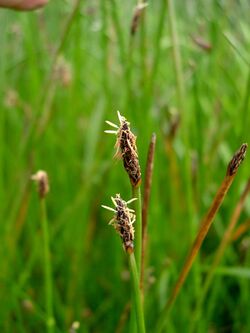Biology:Eleocharis macrostachya
Distribution
| Eleocharis macrostachya | |
|---|---|

| |
| Scientific classification | |
| Kingdom: | Plantae |
| Clade: | Tracheophytes |
| Clade: | Angiosperms |
| Clade: | Monocots |
| Clade: | Commelinids |
| Order: | Poales |
| Family: | Cyperaceae |
| Genus: | Eleocharis |
| Species: | E. macrostachya
|
| Binomial name | |
| Eleocharis macrostachya | |
| Synonyms[2] | |
| |
Eleocharis macrostachya is a species of spikesedge known by the common name pale spikerush.[3]
It is widely distributed in North America and occurs in parts of South America.[2][4] It is a plant of varied moist habitats, including freshwater lakes and brackish marshes and ponds, ditches, vernal pools, and wet meadows.
Description
Eleocharis macrostachya is a rhizomatous perennial with bright green erect stems and straw-colored basal leaves, typically reaching heights between one half and one meter. At the top of each stem is a narrow, lance-shaped or cylindrical inflorescence, featuring a single spike ranging from 5 to 40 mm long. This spike contains 30 to 80 spirally arranged florets, each under a scale measuring 2 to 5.5 mm, usually reddish or orange-brown. The lowest scale wraps around 75-100% of the stem without a flower, and the second lowest may or may not have a flower. The leaves are bladeless sheaths on the lower stem, and the upper sheath is firm and often reddish towards the base. Stems, which are erect with up to 25 vertical ribs, form colonies from long rhizomes.
Each flower produces a single seed (achene) that drops independently of the scale. Achenes are 1.1 to 1.9 mm long, yellowish to dark brown, with a distinct tubercle at the tip, measuring one or two millimeters long.[5] Tubercles are whitish to dark brown, pyramidal, .3 to .7 mm long. Additionally, around the achene are 4 barbed bristles, pale brown to whitish, and they may sometimes be absent.
Use in phytoremediation
E. macrostachya has been studied as part of wetland restoration, as well as the removal of arsenic in groundwater via rhizofiltration as part of phytoremediation.[6][7] Wetlands have the capacity to remove many conventional contaminants from wastewater, even in highly saline water.[8] Olmos-Marquez (2012) identified E. macrostachya as having the greatest arsenic retention in an experimental wetland, suggesting that it acts as a rhizofiltrator.[9]
References
- ↑ Lansdown, R.V. (2016). "Eleocharis macrostachya". IUCN Red List of Threatened Species 2016: e.T64311298A66891680. doi:10.2305/IUCN.UK.2016-1.RLTS.T64311298A66891680.en. https://www.iucnredlist.org/species/64311298/66891680. Retrieved 24 December 2022.
- ↑ 2.0 2.1 Kew World Checklist of Selected Plant Families
- ↑ "Eleocharis macrostachya (Pale Spikerush): Minnesota Wildflowers" (in en). https://www.minnesotawildflowers.info/grass-sedge-rush/pale-spikerush.
- ↑ {{citation | mode = cs1 | title = Eleocharis macrostachya | work = Germplasm Resources Information Network (GRIN) | url = | publisher = [[Organization:Agricultural Research ServAgricultural Research Service (ARS), United States Department of Agriculture (USDA) | access-date = 2013-01-22 }}
- ↑ "Eleocharis macrostachya in Flora of North America @ efloras.org". http://www.efloras.org/florataxon.aspx?flora_id=1&taxon_id=242101136.
- ↑ Fraser, Alexandra; Kindscher, Kelly (2001-12-01). "Tree spade transplanting of Spartina pectinata (Link) and Eleocharis macrostachya (Britt.) in a prairie wetland restoration site" (in en). Aquatic Botany 71 (4): 297–304. doi:10.1016/S0304-3770(01)00185-1. ISSN 0304-3770. https://www.sciencedirect.com/science/article/abs/pii/S0304377001001851.
- ↑ Márquez, Mario Alberto Olmos; Rivero, Jesús Manuel Ochoa; Herrera, María Teresa Alarcón; Estrada, Eduardo Santellano; Vega-Mares, José Humberto; Aragón, María Cecilia Valles (2020). "Performance of a Pilot Subsurface Flow Treatment Wetland System, Used for Arsenic Removal from Reverse Osmosis Concentrate, in the Municipality of Julimes, Chihuahua, Mexico". Ingeniería y universidad 24 (24): 10. ISSN 0123-2126. https://dialnet.unirioja.es/servlet/articulo?codigo=7906810.
- ↑ Berg, Elisa C.; Borges, Alisson C. (2020). "Use of plants in the remediation of arsenic-contaminated waters" (in en). Water Environment Research 92 (10): 1669–1676. doi:10.1002/wer.1419. ISSN 1554-7531.
- ↑ Olmos-Márquez, Mario Alberto; Alarcón-Herrera, Maria Teresa; Martín-Domínguez, Ignacio Ramiro (2012-03-01). "Performance of Eleocharis macrostachya and its importance for arsenic retention in constructed wetlands" (in en). Environmental Science and Pollution Research 19 (3): 763–771. doi:10.1007/s11356-011-0598-x. ISSN 1614-7499. PMID 21935698. https://doi.org/10.1007/s11356-011-0598-x.
External links
- Jepson Manual Treatment: Eleocharis macrostachya
- USDA Plants Profile — Eleocharis macrostachya (pale spikerush)
- Eleocharis macrostachya — U.C. Photo gallery
- C.Michael Hogan ed. 2010. Eleocharis macrostachya. Encyclopedia of Life
Wikidata ☰ Q5359217 entry
 |


